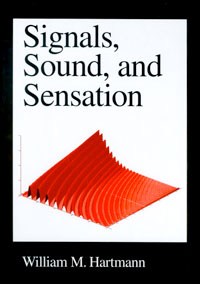

SIGNALS, SOUND, AND SENSATION
William M. Hartmann

Signals, Sound, and Sensation is a text about
signals, audio, acoustics, and mainly psychoacoustics.
It assumes that the reader is comfortable with elementary
calculus.
It can be purchased from:
Springer-Verlag
333 Meadowlands Parkway
Secaucus, NJ, 07094
TOLL FREE: 1-800-777-4643
CONTENTS
Chapter 1. The Pure Tone
Mathematics of the pure tone
* H.R. Hertz
The spectrum
The importance of the pure tone in psychoacoustics
The sound of a pure tone
Chapter 2. Complex Representation
Complex numbers - rectangular form
Complex numbers - polar form
Addition of complex numbers
Multiplication of complex numbers
Complex conjugate and the absolute value
Reciprocal of a complex number
Phasors
Chapter 3. Power, Intensity, and Decibels
Average power and RMS value
Crest factor
Decibels
Acoustics: pressure and intensity
Waves in time and space
* Lord Rayleigh
Measuring sound pressure levels
Adding signals
Spectral density and spectrum level
Observations on the decibel scale
A note on metric units of pressure
Chapter 4. Intensity and Loudness
Loudness level
Difference limens
Psychophysics
Intensity difference limens and loudness
* H. Fletcher
Loudness summation across frequency
Temporal integration
Chapter 5. Fourier Series
* J.B.J. Fourier
Definition of Fourier series
Projecting of functions
The spectrum
Symmetry
Computer evaluation of Fourier series coefficients
Chapter 6. Perception of Periodic Complex Tones
Musical tones and their sources
Harmonic analysis by the auditory periphery
Method: Pulsation threshold
Hearing out harmonics
Method: Bekesy tracking
Segregation and integration
Pitch and tone color
* G.S. Ohm
Pitch, chroma, and Shepard tones
Chapter 7. Delta Functions
Basic definition
Relation to the unit step function
Translation and selection properties
Application to Fourier transforms
Relation to the Kronecker delta
Further properties of the delta function
The lattice sum
Representations of the delta function
Chapter 8. The Fourier Integral
The transforms defined
Transforms of sine and cosine
Real functions, even and odd functions
Time shifting
Derivatives and integrals
Convolution
Introduction to correlation functions
Introduction to filtering
Periodic functions - Fourier series
Periodic functions and the lattice sum
Large and small scales
Fourier transforms of sgn and theta
Chapter 9. Filters
Filter fundamentals
The first-order filter
The second-order filter
The transversal filter
Dispersion relations
All-pass filters
Minimum-phase filters
Transfer function of the Hilbert transformer
Measuring transfer functions and coherence
Chapter 10. Auditory Filters
Cochlear tuning
Excitation patterns and critical bands
Critical bandwidth
* H.G. Barkhausen
The gammatone filter
The ubiquitous critical band
Chapter 11. Musical Measures of Frequency
Intervals
Dividing the octave
The unit of cents
Absolute musical scale
* H.L.F. von Helmholtz
Stretched and compressed tuning
Chapter 12. Pitch of Sine Tones
The definition of pitch
The dependence of pitch on intensity
Diplacusis, threshold microstructure, and emissions
Noise-induced pitch shift
Post-stimulatory pitch shift
Place theories and timing theories
* G. von Bekesy
The mel scale
The pitches of sines and complex tones
Chapter 13. Applications of the Fourier Transform
The energy spectrum and power spectrum
* S.S. Stevens
The alternating lattice
The forgetful Fourier transformer
The uncertainty principle
The spectral rake
Caveat on representations
Chapter 14. Correlation Functions and Spectra
The finite-duration signal autocorrelation function
The infinite-duration signal autocorrelation function
Autocorrelation for bands of noise
The symmetry of the autocorrelation function
Cross-correlation in three easy cases
The cross-spectrum
The Revcor technique
Autocorrelation and pitch perception
Chapter 15. Delay-and-Add Filtering
Impulse response and transfer function for delay and add
Repetition pitch
The comb filter
Delay-and-add filters in motion
Chapter 16. Probability Density Functions
Derivation of the PDF
PDF for the sum of two functions
PDF for random events
Averages and the PDF
Central moments
Chapter 17. Beats and Amplitude Modulation
Beats of equal-amplitude sines
Beats of sines with unequal amplitudes
Amplitude modulation
Balanced modulation
Beats and the frequency-domain grating
Chapter 18. The Envelope
Formal evaluation of the envelope
Envelope rules
Calculation of the envelope
The envelope and the Hilbert transform
* D. Hilbert
More envelope rules
The envelope and perception
Ensemble-average envelope
Chapter 19. Frequency Modulation
Narrow-band FM
Wide-band FM
The detection of frequency modulation
Chapter 20. Modulation Detection and Perception
Mixed modulation
Modulation detection and the critical band
FM and AM detection unified?
Masking by two tones
The modulation transfer function
Roughness
Chapter 21. Sampled Signals
The digitized signal
The sampled signal
The output signal
Sampling-jitter noise
The discrete Fourier transform
The fast Fourier transform
Oversampling
Chapter 22. Nonlinear Distortion
Memoryless representation
Dynamical representation
Harmonic distortion
Measurement of harmonic distortion
Intermodulation distortion
Distortion and audibility of phase
Auditory nonlinearity
Dynamic range compression
Chapter 23. Noise
Gaussian and thermal noise
Making noise
The power spectrum
The color of noise
Uniform exciting noise
* E.G. Wever
Noise fluctuations
Chapter 24. Signal Detection Theory
Two-alternative forced-choice
(M+1)-alternative forced-choice
Yes-No
* G.T. Fechner
Trials and procedures
Staircase methods
Efficiency
APPENDICES
A. Greek Alphabet
B. Trigonometric Functions
Definitions
Angle sum and difference formulas
Euler's formula and equivalents
C. Series
Infinite series
Binomial series
Geometric series
Special finite series
Special infinite series
D. Integrals - Even and Odd Functions
E. Integrals in the Complex Plane
Impulse response and the residue
Hilbert transform integrals
F. Hilbert Transform
Components of the analytic signal
Dispersion relations
Minimum-phase filters, gain and phase shift
G. Electrical Filters
H. The Normal Distribution
The error function
The cumulative normal
The central limit theorem
I. The Rayleigh Distribution
Generating random numbers having Gaussian and Rayleigh distributions
J. Standards
ISO frequencies
Mathematical constants
Units of pressure and hearing threshold
Physical constants
K. Calculation of Intermodulation Distortion
References
Index